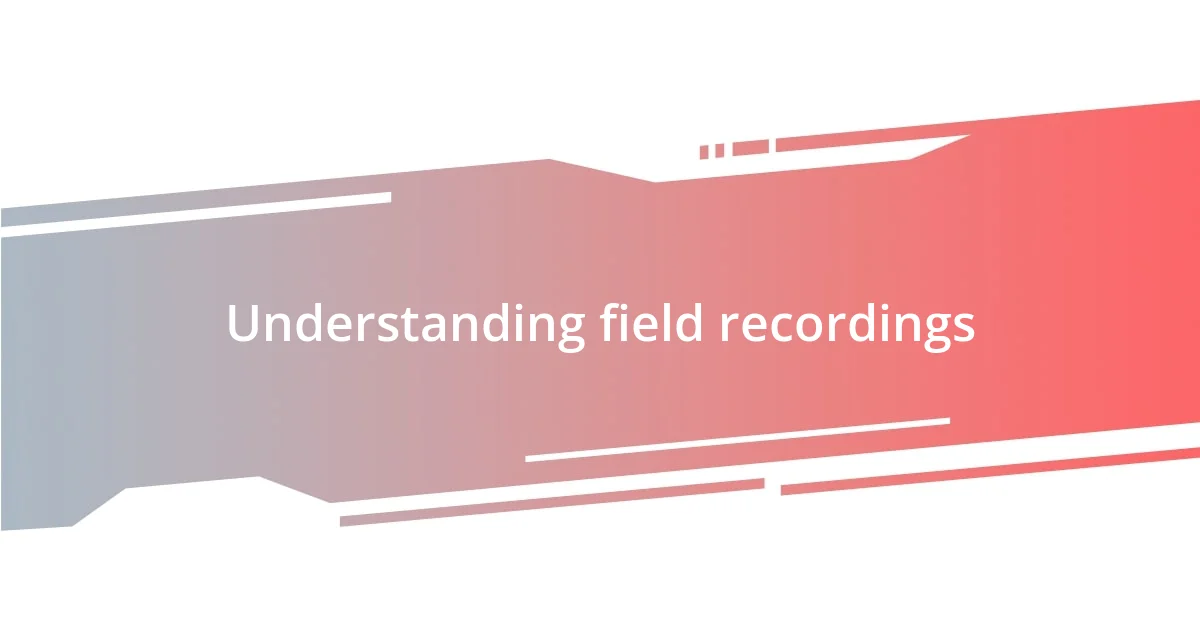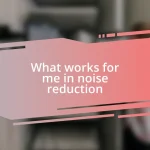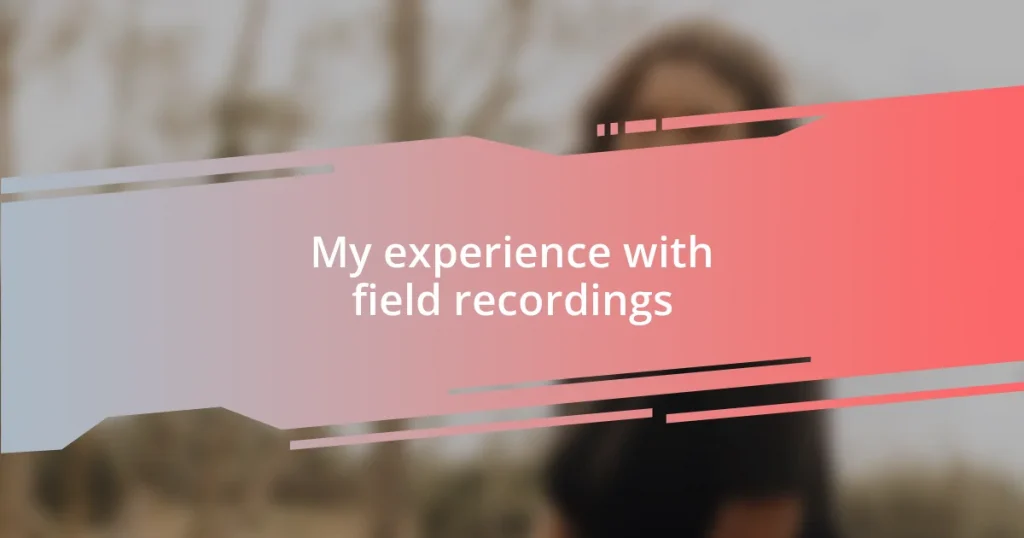Key takeaways:
- Field recordings evoke emotions and preserve authentic moments from various environments, capturing the essence of experiences.
- Choosing the right equipment and employing effective recording techniques enhances sound quality, whether in serene rural settings or bustling urban landscapes.
- Sharing recordings with storytelling and engaging with the audience fosters connection and allows for greater appreciation of the nuanced beauty in soundscapes.

Understanding field recordings
Field recordings are essentially audio captures of sounds from our environment, and they can evoke a wide range of emotions. I remember wandering through a bustling city market, recording snippets of laughter, vendor calls, and the rustling of bags. When I played it back later, the sounds transported me right back to that vibrant moment, reminding me of the energy and life around me. Have you ever listened to a sound and felt the memory of a place wash over you?
The beauty of field recordings lies in their authenticity; they capture the essence of a moment that might otherwise be forgotten. I often find myself drawn to quiet parks or urban alleyways, where the unexpected sounds tell their own stories. It’s fascinating to think about how a distant train horn or the chirping of birds can create a rich tapestry of ambient sound, each element contributing to the atmosphere and mood of the recording. What do you think makes a sound memorable for you?
In my journey with field recordings, I’ve realized that it’s not just about the act of capturing sound, but about attentively listening to the world around us. Each session becomes a meditative experience, tuning me into the subtleties that often go unnoticed. I’ve experienced moments where sitting still, simply listening, led me to discover sounds that stirred deep emotions within me, perhaps because they spoke to a personal memory or connection. Have you noticed how sometimes, it only takes one sound to stir an entire feeling?

Choosing the right equipment
Choosing the right equipment is pivotal in capturing the essence of your field recordings. Early in my explorations, I invested in a high-quality portable recorder, which made a world of difference. I vividly remember standing beside a serene lake, and the crisp, clear sound of water lapping against the shore was beautifully captured, something a lesser device couldn’t have done. A portable recorder ensures versatility, allowing you to chase sounds in various environments, from bustling streets to tranquil forests.
When it comes to equipment, consider the following:
- Microphone Type: Condenser mics are excellent for capturing detailed sounds, while dynamic mics work well in louder environments.
- Wind Protection: A good windscreen is essential; even a gentle breeze can ruin an otherwise perfect recording.
- Quality of Recorders: Look for recorders with a high bit rate for clearer audio.
- Portability: Ensure your gear is lightweight and easy to carry, as you often discover sounds on the go.
- Headphones: Invest in good, closed-back headphones to monitor your recordings effectively, helping you hear nuances in real-time.
I hope sharing these insights will help you choose the right equipment and lead to stunning recordings of your own.

Techniques for effective recording
When I head out for field recordings, I often rely on a few specific techniques that enhance the quality of my captures. One of my favorites is to explore the environment beforehand. For instance, I’ll often walk around a location quietly to familiarize myself with the different sounds available. This little reconnaissance can lead to unexpected surprises, like the joyful laughter of children hidden behind a park’s trees or the faint sound of distant church bells that adds a layer of nostalgia.
Another technique I’ve found effective is experimenting with different microphone placements. I recall one recording session where I placed my microphone low to the ground next to some busy urban traffic. The resulting sound—like a chaotic dance of honking cars and rushing pedestrians—brought an entirely new perspective to my project. It’s a simple adjustment, but it can make all the difference in capturing the essence of a moment.
Lastly, I always make it a point to record in diverse conditions. I remember a rainy day when I decided to head out despite the weather. The sound of raindrops hitting leaves and puddles created a soothing, rhythmic backdrop that I’d never have captured otherwise. Each environment offers a unique flavor to the recordings, and embracing the unexpected can lead to some of the most memorable audio experiences.
| Technique | Description |
|---|---|
| Exploration | Walk around the location to identify interesting sounds before recording. |
| Microphone Placement | Experiment with different microphone positions to capture unique audio perspectives. |
| Diverse Conditions | Record in varied weather or settings to achieve a richer soundscape. |

Best practices in various environments
When recording in rural or natural environments, I’ve learned that patience is key. One afternoon, I found myself in a secluded forest, waiting for what felt like ages for the wind to die down. Believe me, that quiet moment was worth the wait; when the silence finally fell, the subtle sounds of leaves rustling and distant bird calls enveloped me, creating a serene audio tapestry. In such peaceful atmospheres, the beauty of subtlety often shines through, allowing the subtle nuances of nature to come alive in your recordings.
In urban settings, however, the hustle and bustle requires a different approach. I vividly recall one evening trying to capture the vibrant nightlife of a city. I positioned myself near a lively street corner, but instead of just utilizing my recorder, I engaged with the sounds—a spontaneous street musician started playing nearby. This unexpected moment transformed my recording into a dynamic blend of ambient noise and an impromptu concert. Urban environments are full of surprises; being open to spontaneity can lead to rich, layered recordings that tell a compelling story.
Controlling background noise in busy environments can be a challenge. I once tackled this during a crowded festival; the immediate din threatened to overpower my recordings. I quickly adapted by using directional microphones to focus on specific sounds while minimizing unwanted noise. What I learned is that, sometimes, what seems like an obstacle can turn into a creative opportunity if you’re willing to think on your feet. Have you ever tried tweaking your recording techniques to adapt to challenging situations? I can assure you, embracing the unexpected leads to unique audio treasures.

Editing and processing recordings
Editing and processing recordings can be both a rewarding and meticulous process. After I finish a field recording, I often sit down with my audio software, eager to bring those raw sounds to life. For instance, I remember one particular recording session where I captured a gentle babbling brook. Initially, the playback was mesmerizing but lacked clarity. So, I went through the recording layer by layer, adjusting the levels and applying a touch of EQ to highlight the crispness of the water over the rocks. It’s amazing how a little tweaking can transform a soundscape.
Often, I find that noise reduction is a critical step in the editing journey. During a bustling day at a local market, I recorded the vibrant atmosphere but was frustrated to discover the overwhelming background chatter. My go-to solution was applying a noise gate, which allows softer sounds—like the laughter of children—to come through while effectively filtering out the louder distractions. Have you ever dealt with unwanted noise in your recordings? Learning these tools took time, but they made a significant difference in achieving a more polished result.
Lastly, I adore adding subtle effects to enhance the listening experience. For instance, in a recent project, I combined a field recording of distant thunder with a light reverb effect. The outcome made listeners feel as if they were truly transported to that moment, surrounded by the tension in the air before a storm. Each choice during editing shapes the story your audio tells. It’s a blend of artistry and technical skill. What creative decisions have you made in your recordings that took them to another level? In my experience, it’s all about exploring possibilities and letting your unique vision guide you.

Sharing your field recordings
Sharing field recordings is like sharing a piece of your soul. I remember the first time I uploaded a nature soundscape to an online community dedicated to field recordings. The feedback was overwhelming! It felt incredible to connect with others who appreciated the same subtle beauty I had experienced. When you share your work, you’re opening a door for listeners to step into the world you’ve captured—it’s an intimate experience that fosters connection.
Engaging with the audience is another vital aspect of sharing. I often accompany my recordings with a brief story about where and how I captured them. Just recently, I shared a recording from a foggy morning at a lake, describing how the mist enveloped me in serenity. I noticed that listeners resonated more with the recording when I shared that emotional context. Have you ever considered how much more powerful your recordings can become with a little storytelling? It can transform a simple sound into a rich, immersive experience that keeps listeners coming back for more.
Social media has also become an invaluable tool for showcasing my field recordings. Sharing snippets with accompanying visuals not only captures attention but also invites dialogue and feedback. It’s fascinating to see different interpretations from listeners, sometimes noting nuances that I hadn’t even considered. When I shared a vibrant urban soundscape, someone mentioned feeling as if they were right there with me, which warmed my heart. How do you think your recordings evoke emotions in others? Finding that connection often leads to authentic conversations and collaboration opportunities in the community.

Personal reflections and future goals
Reflecting on my journey with field recordings, I realize how much my approach has evolved over time. I used to capture sounds without much thought, but now, I view each recording session as an adventure. I can still vividly recall the excitement of recording the soft rustle of leaves during a quiet sunset walk. It felt like eavesdropping on nature’s conversation. Do you ever find yourself so immersed in your surroundings that the world fades away?
Looking ahead, my goals are becoming clearer. I want to experiment with more unconventional settings and combine those sounds with music. Recently, I’ve been toying with the idea of integrating spoken word poetry into my recordings, creating a layered audio experience. Have you ever considered how different elements can work together to tell a deeper story? I believe the fusion of sound and narrative can enhance the emotional resonance of my work while inviting listeners into a richer world.
Moreover, I aspire to create a community around field recordings where we can exchange ideas and inspire each other. I’ve experienced the power of collaboration firsthand—once, I collaborated on a project that combined my ambient sounds with a friend’s acoustic guitar, and the result was breathtaking. How might your contributions impact others? I genuinely believe that by sharing our experiences and knowledge, we can elevate the art of field recordings to new heights.















